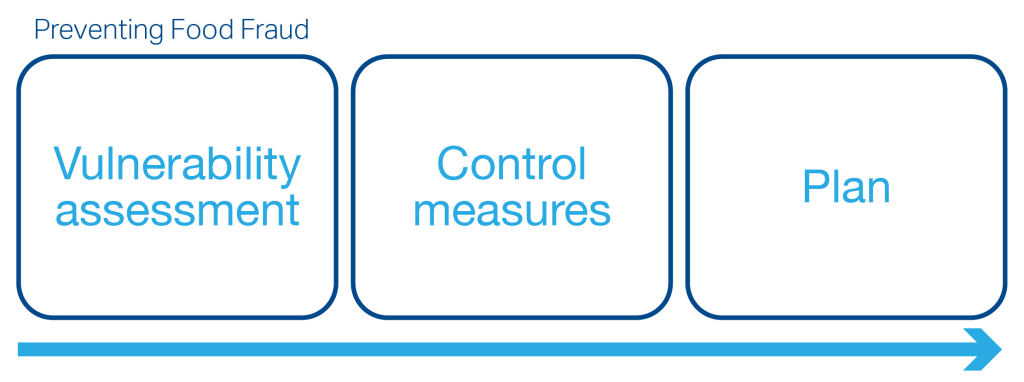Reviewed and Approved by Justin Derington, Director of Auditing Services, FSNS Certification & Audit
1-Minute Summary
- FSSC 22000 Version 6 introduces stringent labeling, food defense, and fraud mitigation requirements.
- Enhanced allergen management and environmental monitoring protocols are now in effect.
- A robust Food Safety and Quality Culture Plan is mandatory under the new standard.
- Quality control now mirrors CCPs in food safety, emphasizing active management and documentation.
FSSC 22000 Version 6 is Here
FSSC 22000 Version 6 took effect on April 1, 2023. Facilities that audit to the FSSC 22000 standard have a 12-month window to prepare, but all FSSC 22000 audits on or after April 1, 2024 must be done against Version 6 of the standard.
While Version 6 is aligned with Version 5.1, it introduces several new requirements for which the auditor will be looking. This added specificity reflects the industry’s ongoing advancements and the growing demand for transparency and accountability.
With that in mind, let’s look at 6 key changes in FSSC 22000 Version 6; read the entire FSSC 22000 Version 6 standard to be fully prepared.

1) Product Labeling and Printed Materials (2.5.2)
Version 6 labeling requirements are more detailed and robust than in Version 5.1 of the standard. These changes align with consumer needs and regulatory expectations.
Highlights include…
- Enhanced Specificity: Version 6 places a stronger emphasis on customer-specific labeling requirements in addition to general statutory and regulatory compliance.
- Traceability Enhancement: Detailed traceability information is now required on labels to improve product-origin tracking.
- Label Claim Verification: The new version mandates validation and verification of label claims to ensure authenticity and integrity.
- Artwork and Print Control: Version 6 introduces specific procedures for managing artwork and print control for food chain category I to meet legal and customer requirements.

FSSC 22000 v6 mandates validation and verification of label claims.
2) Food Defense and Food Fraud Mitigation (2.5.3 & 2.5.4)
The FSSC 22000 Version 6 clauses related to food fraud mitigation of food defense are more detailed than in Version 5.1.
These changes are a testament to the evolving threats facing the industry. These enhancements serve to shield the supply chain from intentional adulteration and ensure the integrity of food products.
Food Defense (2.5.3)
- Documentation and Implementation: While Version 5.1 required a documented procedure for threat assessment and mitigation, Version 6 specifies that the food defense plan must be reviewed at least annually or more often when significant changes occur or new threats are identified.
- Scope of the Defense Plan: Version 6 emphasizes ensuring that suppliers for food chain category FI have a food defense plan in place, extending the responsibility beyond the organization’s immediate operations.
Food Fraud Mitigation (2.5.4)
- Vulnerability Assessment Specifics: Version 6 mandates that the food fraud vulnerability assessment include both internal and external elements. This comprehensive approach is designed to address the entirety of the supply chain.
- Implementation of Mitigation Measures: The updated standard requires not only the development but also the implementation of mitigation measures.
- Plan Review and Adaptation: Organizations must now review their food fraud mitigation plan following significant changes or when new vulnerabilities are detected, ensuring that the plan remains current and effective.

3) Management of Allergens (2.5.6)
Updates to allergen management highlight the importance of rigorous protocols to prevent allergen cross-contamination and to safeguard sensitive consumers. These revisions are designed to help reduce allergen-related incidents, which are one of the top reasons for food recalls.
To that end, here are the highlights of FSSC 22000 Version 6:
- Risk Assessment Scope: Version 6 expands the risk assessment to ensure validation of control measures, whereas Version 5.1 focused on assessing potential sources of allergen cross-contamination.
- Cross-Contamination Control Measures: Version 6 details specific verification of control measures to mitigate cross-contamination.
- Labeling Requirements: Version 6 includes additional labeling controls, especially regarding precautionary allergen labeling and its verification.
- Employee Training: Explicit training requirements for all personnel in allergen management are introduced in Version 6.
- Review and Update: The updated standard calls for an annual review of the allergen management plan and updates as needed, particularly after significant changes.
4) Environmental Monitoring (2.5.7)
FSSC 22000 Version 6 introduces nuanced yet powerful changes to your environmental monitoring program (EMP), with a clear shift toward more frequent, data-driven reviews and a defined set of triggers for revaluation. Below are the key distinctions:
- Review Triggers: Version 6 explicitly defines specific events that necessitate a review of the environmental monitoring program, such as significant operational changes or the detection of pathogens.
- Review Frequency: The updated version requires at least an annual review of the environmental monitoring program, promoting regular re-assessment to ensure ongoing effectiveness.
- Data-Driven Review: There is a new emphasis on using data trends from environmental monitoring as a basis for reviewing and adjusting the program, enhancing the rigor of the program’s evaluation process.

5) Food Safety and Quality Culture (2.5.8)
The requirements in clause 2.5.8 to develop a robust Food Safety and Quality Culture (FSQC) within organizations may be the most sweeping change to FSSC 22000 Version 6. It promises to have a profound effect on food facilities.
This clause underscores the importance of establishing a foundation of shared values, beliefs, and norms that drive a proactive approach to food safety behaviors and practices, going beyond compliance and procedures to the underlying ethos of how your organization operates.
Under the standard, an FSQC plan must include:
- Communication: Open, clear, and ongoing dialogue about food safety practices and expectations at all levels of the organization.
- Training: Comprehensive and continuous food safety training and education programs that empower all employees to uphold food safety standards.
- Employee Feedback: Mechanisms for staff to voice concerns, contribute ideas, and be an active part of the food safety conversation.
- Performance Measurement: Objective metrics to assess and improve food safety activities, ensuring they meet the established goals.

Open, clear communication must be part of your food safety quality culture under FSSC 22000 v6.
6) Quality Control (2.5.9)
FSSC 22000 version 6 includes a stronger emphasis on Quality Control (QC) within food safety systems. This clause mandates the establishment of rigorous QC measures akin to Critical Control Points for quality, requiring organizations to actively manage and document quality at every stage of the production process.
Key Aspects of Clause 2.5.9 include:
- Alignment with ISO Standards: QC is to be integrated with quality policies and objectives as outlined in ISO 22000:2018.
- Quality Parameters Definition: Establish, implement, and maintain clear quality parameters, including upper and lower limits, for all products.
- Calibration and Verification: Implement quantity control procedures and regularly calibrate and verify equipment used for quality and quantity control.
- Start-up and Change-over Controls: Ensure procedures are in place to manage start-up and change-over processes, maintaining product integrity and compliance.
This shift underscores the evolution of FSSC 22000 towards a holistic approach that equally weighs food safety and quality control in food production.
Additional Important Changes in FSSC 22000 Version 6
FSSC 22000 Version 6 includes additional important updates to understand before your next audit. Here is a rundown of some of them:
Management of Services and Purchased Materials (2.5.1)
- Recycled Packaging Criteria: Version 6 introduces specific criteria for the use of recycled packaging as a raw material input, ensuring it meets the same safety and quality requirements as other materials.
- Expansion of Requirements for Specific Food Chain Categories: While both versions require documented procedures for emergency procurement and policies for procurement of animals, fish, and seafood, Version 6 extends these requirements to additional food chain categories and includes the management of raw material and finished product specifications.
Logo Use (2.5.5)
- Version 6 clarifies that certified organizations must not imply FSSC 22000 approval on their products, labels, or packaging with the logo, which is consistent with version 5.1 but specifies additional contexts like certificates of analysis or conformity and exclusions to the scope of certification.

Transport, Storage, and Warehousing (2.5.10)
- Tanker Transport: Version 6 includes additional requirements for organizations using tankers for transport, requiring a documented risk-based plan for addressing tanker cleaning and cross-contamination measures.
- Enhanced Specificity in Storage and Warehousing: The updated version specifies that the stock rotation system must include FEFO (First Expired, First Out) principles in conjunction with FIFO (First In, First Out) requirements.
- Post-Slaughter Requirements: There is a new stipulation in Version 6 for food chain category C0, detailing post-slaughter time and temperature requirements to ensure product safety during chilling or freezing.
- Contamination Prevention in Transport: Version 6 provides specific guidelines for food chain category FI to ensure that product transport and delivery minimize the potential for contamination.
Hazard Control and Measures for Preventing Cross-Contamination (2.5.11)
- Packaging Requirements for Food Chain Category I: Version 6 maintains the requirement from 5.1 for specific requirements in cases where packaging is used to impart a functional effect on food, such as shelf-life extension.
- Inspection Process for Food Chain Category CI: Both versions require specific inspection procedures to ensure animals are fit for human consumption; however, Version 6 elaborates on managing the use of substances with potential adverse animal health effects and includes a broader range of food chain categories.
- Foreign Matter Management: Version 6 introduces comprehensive requirements for managing foreign matter, mandating a documented risk assessment, and specifying the type of detection equipment necessary.
Product Design and Development (2.5.13)
- Introduction of Shelf-life Verification Process: FSSC 22000 Version 6 contains a requirement for an ongoing shelf-life verification process.
- Cooking Instructions Validation: Version 6 also requires that cooking instructions provided on the label or packaging for ready-to-cook products be validated to ensure food safety.
Our contract research division, FSNS Lab+, can help design your shelf-life study protocol, conduct shelf-life testing, and perform cooking instruction validations.
Communication Requirements
FSSC 22000 Version 6 includes rules for communicating serious events to your Certification Body, which is a new addition compared to Version 5.1.
- Timely Reporting: Organizations must inform their certification body within 3 working days of events that affect the Food Safety Management System (FSMS) or the integrity of the certification.
- Scope of Reportable Events: Reportable events include serious incidents affecting food safety, legal compliance, or certification integrity due to factors like natural disasters, malicious activities, or serious public food safety events.
- Risk to Certification Integrity: Situations that could potentially damage the reputation of the certification, such as public recalls, regulatory actions, or legal issues, must be promptly communicated to the certification body.
Questions? Ready to Schedule Your FSSC 22000 Audit?
FSSC 22000 Version 6 presents new requirements that affirm an organization’s commitment to food safety and quality. It’s vital for businesses to stay ahead of these changes to ensure compliance and maintain the integrity of their food safety management systems.
If you have questions about the transition or need to schedule an FSSC audit to the Version 6 standard, reach out to our certification and audit team.



